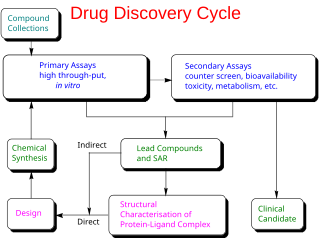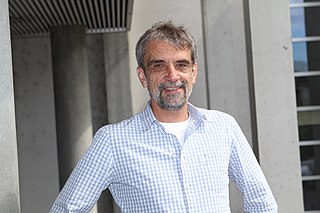
Drug design, often referred to as rational drug design or simply rational design, is the inventive process of finding new medications based on the knowledge of a biological target. The drug is most commonly an organic small molecule that activates or inhibits the function of a biomolecule such as a protein, which in turn results in a therapeutic benefit to the patient. In the most basic sense, drug design involves the design of molecules that are complementary in shape and charge to the biomolecular target with which they interact and therefore will bind to it. Drug design frequently but not necessarily relies on computer modeling techniques. This type of modeling is sometimes referred to as computer-aided drug design. Finally, drug design that relies on the knowledge of the three-dimensional structure of the biomolecular target is known as structure-based drug design. In addition to small molecules, biopharmaceuticals including peptides and especially therapeutic antibodies are an increasingly important class of drugs and computational methods for improving the affinity, selectivity, and stability of these protein-based therapeutics have also been developed.

Protein–protein interactions (PPIs) are physical contacts of high specificity established between two or more protein molecules as a result of biochemical events steered by interactions that include electrostatic forces, hydrogen bonding and the hydrophobic effect. Many are physical contacts with molecular associations between chains that occur in a cell or in a living organism in a specific biomolecular context.
Cross-linking and immunoprecipitation is a method used in molecular biology that combines UV crosslinking with immunoprecipitation in order to identify RNA binding sites of proteins on a transcriptome-wide scale, thereby increasing our understanding of post-transcriptional regulatory networks. CLIP can be used either with antibodies against endogenous proteins, or with common peptide tags or affinity purification, which enables the possibility of profiling model organisms or RBPs otherwise lacking suitable antibodies.

Molecular biophysics is a rapidly evolving interdisciplinary area of research that combines concepts in physics, chemistry, engineering, mathematics and biology. It seeks to understand biomolecular systems and explain biological function in terms of molecular structure, structural organization, and dynamic behaviour at various levels of complexity. This discipline covers topics such as the measurement of molecular forces, molecular associations, allosteric interactions, Brownian motion, and cable theory. Additional areas of study can be found on Outline of Biophysics. The discipline has required development of specialized equipment and procedures capable of imaging and manipulating minute living structures, as well as novel experimental approaches.
ChIP-sequencing, also known as ChIP-seq, is a method used to analyze protein interactions with DNA. ChIP-seq combines chromatin immunoprecipitation (ChIP) with massively parallel DNA sequencing to identify the binding sites of DNA-associated proteins. It can be used to map global binding sites precisely for any protein of interest. Previously, ChIP-on-chip was the most common technique utilized to study these protein–DNA relations.
PAR-CLIP is a biochemical method for identifying the binding sites of cellular RNA-binding proteins (RBPs) and microRNA-containing ribonucleoprotein complexes (miRNPs). The method relies on the incorporation of ribonucleoside analogs that are photoreactive, such as 4-thiouridine (4-SU) and 6-thioguanosine (6-SG), into nascent RNA transcripts by living cells. Irradiation of the cells by ultraviolet light of 365 nm wavelength induces efficient crosslinking of photoreactive nucleoside–labeled cellular RNAs to interacting RBPs. Immunoprecipitation of the RBP of interest is followed by isolation of the crosslinked and coimmunoprecipitated RNA. The isolated RNA is converted into a cDNA library and is deep sequenced using next-generation sequencing technology.
CLIPZ is a database of post-transcriptional regulatory elements built from cross-linking and immunoprecipitation data.
High-throughput sequencing of RNA isolated by crosslinking immunoprecipitation (HITS-CLIP) is a variant of CLIP for genome-wide mapping protein–RNA binding sites or RNA modification sites in vivo. HITS-CLIP was originally used to generate genome-wide protein-RNA interaction maps for the neuron-specific RNA-binding protein and splicing factor NOVA1 and NOVA2; since then a number of other splicing factor maps have been generated, including those for PTB, RbFox2, SFRS1, hnRNP C, and even N6-Methyladenosine (m6A) mRNA modifications.
iCLIP is a variant of the original CLIP method used for identifying protein-RNA interactions, which uses UV light to covalently bind proteins and RNA molecules to identify RNA binding sites of proteins. This crosslinking step has generally less background than standard RNA immunoprecipitation (RIP) protocols, because the covalent bond formed by UV light allows RNA to be fragmented, followed by stringent purification, and this also enables CLIP to identify the positions of protein-RNA interactions. As with all CLIP methods, iCLIP allows for a very stringent purification of the linked protein-RNA complexes by stringent washing during immunoprecipitation followed by SDS-PAGE and transfer to nitrocellulose. The labelled protein-RNA complexes are then visualised for quality control, excised from nitrocellulose, and treated with proteinase to release the RNA, leaving only a few amino acids at the crosslink site of the RNA.

Research at the Biozentrum of the University of Basel is dedicated to the central question of how molecules and cells create life − from atom to organism, and from the physics of life to the dynamics of multicellular systems. Accordingly, the scientists at the Biozentrum are active in a wide range of research fields. These disciplines are not strictly separated from each other, but often overlap, thus leading to new questions and collaborations.

Joachim Heinrich Seelig was a German and Swiss physical chemist and specialist in NMR Spectroscopy. He was one of the founding fathers of the Biozentrum of the University of Basel. He reached emeritus status in 2012.

Anna Seelig-Löffler is a Swiss Biophysical chemist who worked at the Biozentrum University of Basel, Switzerland.

Erik van Nimwegen is a Dutch computational biologist and Professor at the Biozentrum of the University of Basel, Switzerland.

Markus Rüegg is a Swiss neurobiologist and professor at the Biozentrum of the University of Basel.

Peter Scheiffele is a German neurobiologist who conducts research at the Biozentrum of the University of Basel, Switzerland.

Ribonucleoprotein Networks Analyzed by Mutational Profiling (RNP-MaP) is a strategy for probing RNA-protein networks and protein binding sites at a nucleotide resolution. Information about RNP assembly and function can facilitate a better understanding of biological mechanisms. RNP-MaP uses NHS-diazirine (SDA), a hetero-bifunctional crosslinker, to freeze RNA-bound proteins in place. Once the RNA-protein crosslinks are formed, MaP reverse transcription is then conducted to reversely transcribe the protein-bound RNAs as well as introduce mutations at the site of RNA-protein crosslinks. Sequencing results of the cDNAs reveal information about both protein-RNA interaction networks and protein binding sites.

Torsten Schwede is a German and Swiss bioinformatics scientist and Professor at the Biozentrum of the University of Basel, Switzerland. He is also Vice Rector for Research at the University of Basel.

Jürgen Engel is a German-born Swiss chemist and biophysicist.
Gian Gaetano Tartaglia is an Italian biophysicist and computational biologist. He is currently a Principal Investigator at the Italian Institute of Technology.

Sebastian Hiller is a German and Swiss structural biologist and biophysicist. He has been teaching and researching at the Biozentrum of the University of Basel since 2010.













